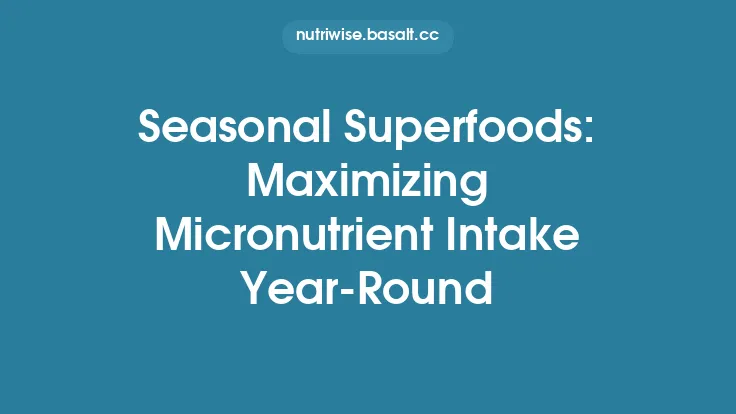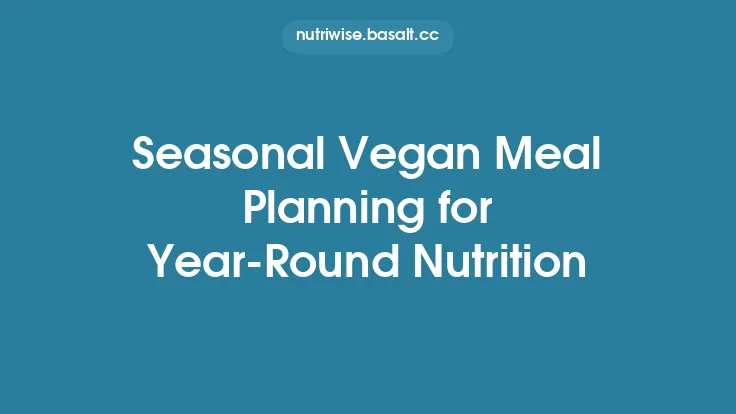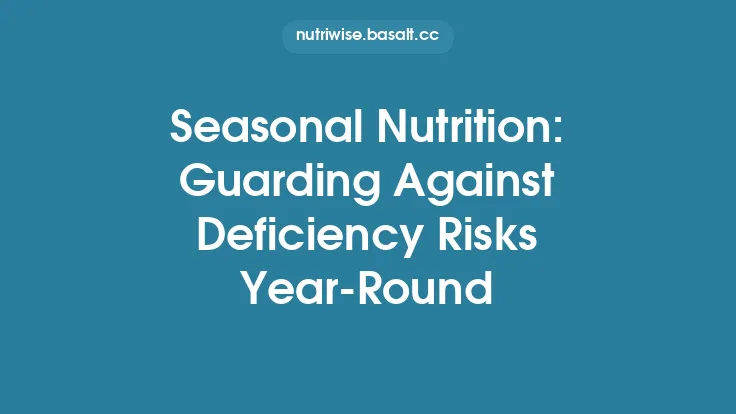Zinc is a trace mineral that quietly underpins many of the body’s defensive mechanisms, from maintaining the integrity of the skin barrier to supporting the activity of immune cells. While the scientific community has long recognized its importance, the everyday challenge for most people is not *whether to include zinc in the diet, but how* to weave zinc‑rich foods into meals throughout the year, regardless of season, budget, or culinary preference. This guide walks you through a practical, season‑by‑season approach to ensuring a steady supply of bioavailable zinc, with tips on selection, storage, preparation, and meal planning that keep your immune resilience robust all year long.
Seasonal Availability of Zinc‑Rich Foods
Understanding which foods naturally contain higher concentrations of zinc—and when they are at their freshest and most affordable—lays the groundwork for a sustainable, year‑round strategy.
| Season | Primary Zinc Sources | Secondary Contributors |
|---|---|---|
| Winter | Oysters, canned sardines, beef shank, fortified cereals | Pumpkin seeds, roasted chickpeas, dark leafy greens (kale, collards) |
| Spring | Lamb, pork tenderloin, quinoa, edamame | Swiss chard, peas, almonds |
| Summer | Grilled chicken breast, turkey, cashews, watermelon seeds | Sun‑dried tomatoes, corn, tofu |
| Autumn | Venison, turkey, wild rice, pumpkin seeds | Brussels sprouts, lentils, hazelnuts |
These groupings are not exhaustive; many foods appear across multiple seasons, but focusing on the highlighted items helps you capitalize on peak freshness, lower cost, and optimal flavor.
Winter Strategies: Harnessing Hearty, Shelf‑Stable Options
Cold months often limit access to fresh produce, but they also bring a bounty of animal‑based zinc sources that store well.
- Seafood Cans and Frozen Packs – Canned oysters, mussels, and sardines retain up to 90 % of their zinc content after canning. Keep a small stash in the pantry for quick protein‑rich snacks or to toss into soups and stews.
- Root Vegetables & Dark Greens – While not as zinc‑dense as meat, kale, collard greens, and turnip greens provide modest amounts and are rich in other immune‑supporting nutrients. Blanching them briefly before freezing preserves both texture and mineral content.
- Legume‑Based Snacks – Roasted chickpeas seasoned with smoked paprika or cumin make a warm, zinc‑boosting snack. Soaking chickpeas overnight reduces phytate levels, enhancing zinc absorption.
- Fortified Breakfast Cereals – Many whole‑grain cereals are fortified with zinc. Pair them with a handful of pumpkin seeds and low‑fat milk for a balanced start to the day.
Practical tip: When cooking winter stews, add a tablespoon of molasses or a splash of soy sauce. Both contain trace zinc and contribute umami depth without overwhelming the dish.
Spring Strategies: Embracing Fresh Greens and Emerging Grains
As the frost thaws, markets fill with tender greens and new‑season grains that can complement animal proteins.
- Quinoa & Amaranth – These pseudo‑cereals deliver about 2 mg of zinc per cooked cup. Their relatively low phytate profile compared with wheat makes the zinc more bioavailable. Rinse thoroughly before cooking to remove saponins that can interfere with mineral uptake.
- Edamame – Fresh or frozen, edamame pods provide a plant‑based zinc boost (≈1 mg per ½ cup). Lightly steam and toss with sea salt for a snack or add to spring salads.
- Lamb Cuts – Spring lamb is often more affordable and tender. Opt for shoulder or shank, which contain higher zinc concentrations than leaner cuts. Slow‑cook with aromatic herbs to create a melt‑in‑the‑mouth dish.
- Spring Peas & Asparagus – While modest in zinc, they pair well with higher‑zinc proteins, creating balanced plates that also supply vitamin C (which can aid zinc absorption).
Practical tip: Soak quinoa for 15 minutes before cooking, then rinse. This simple step reduces residual saponins and improves mineral uptake.
Summer Strategies: Light, Grilled, and Seed‑Rich Meals
Summer’s bounty of fresh vegetables and fruits can be paired with zinc‑dense proteins for vibrant, immune‑supportive meals.
- Grilled Poultry – Chicken and turkey breast, when grilled, retain most of their zinc (≈1 mg per 3‑oz serving). Marinate in citrus‑based sauces; the acidity can modestly increase zinc solubility during cooking.
- Cashews & Watermelon Seeds – A quarter‑cup of roasted cashews supplies roughly 1.5 mg of zinc. Watermelon seeds, often discarded, are a hidden gem—dry‑roast them with a pinch of sea salt for a crunchy topping.
- Tofu & Tempeh – Fermented soy products like tempeh contain higher zinc levels than plain tofu due to the fermentation process breaking down phytates. Slice tempeh thin, marinate, and grill for a smoky flavor.
- Sun‑Dried Tomatoes – Concentrated in minerals, a small handful adds a burst of flavor and a modest zinc contribution to salads or pasta dishes.
Practical tip: When grilling, avoid over‑cooking meat to preserve not only flavor but also the integrity of zinc-containing proteins, which can denature at extreme temperatures.
Autumn Strategies: Harvesting Nuts, Seeds, and Game Meat
Fall brings a shift toward heartier fare, with nuts, seeds, and wild game offering substantial zinc.
- Pumpkin Seeds (Pepitas) – One ounce of roasted pepitas delivers about 2.2 mg of zinc. Toast them lightly with smoked paprika for a savory snack or sprinkle over oatmeal.
- Wild Rice & Barley – While lower in zinc than animal sources, these grains provide a complementary mineral profile. Cooking them in broth enriched with mushroom stock can increase overall zinc content.
- Venison & Turkey – Game meats are naturally lean and zinc‑rich. A 3‑oz serving of venison can contain up to 5 mg of zinc, making it an excellent centerpiece for autumn roasts.
- Brussels Sprouts & Kale – Pair these cruciferous vegetables with zinc‑dense proteins; the slight bitterness balances richer flavors.
Practical tip: Roast pumpkin seeds with a drizzle of olive oil and a sprinkle of sea salt at 300 °F for 10‑12 minutes. This method preserves zinc while enhancing texture.
Maximizing Bioavailability Through Preparation
Even the most zinc‑rich foods can lose their mineral potential if preparation methods are suboptimal. Here are evidence‑based techniques to ensure you reap the most benefit:
- Soaking & Sprouting – Legumes, nuts, and seeds contain phytates that bind zinc. Soaking them for 6‑12 hours (changing the water once) and then sprouting for 1‑2 days dramatically reduces phytate levels, increasing zinc absorption by up to 30 %.
- Fermentation – Fermented foods like tempeh, miso, and kimchi undergo microbial breakdown of phytates and other anti‑nutrients, freeing zinc for easier uptake.
- Gentle Cooking – Steaming or quick sautéing preserves zinc better than prolonged boiling, which can leach minerals into the cooking water. If you do boil, reuse the liquid in soups or sauces to retain the lost zinc.
- Acidic Marinades – Marinating meat in citrus juice, vinegar, or yogurt for 30‑60 minutes can enhance zinc solubility, making it more accessible during digestion.
Building a Year‑Round Zinc Meal Plan
A practical way to guarantee consistent zinc intake is to design a rotating weekly menu that aligns with seasonal produce. Below is a sample framework that can be adapted to personal preferences and dietary restrictions.
| Day | Breakfast | Lunch | Dinner | Snack |
|---|---|---|---|---|
| Mon | Fortified oatmeal + pumpkin seeds | Quinoa salad with edamame, kale, and lemon‑tahini dressing | Grilled lamb shoulder with roasted carrots | Roasted chickpeas |
| Tue | Greek yogurt + cashews + berries | Turkey and avocado wrap on whole‑grain tortilla | Baked salmon (rich in zinc) with sautéed Brussels sprouts | Watermelon seed trail mix |
| Wed | Scrambled eggs with spinach and feta | Lentil soup with barley and a side of toasted pepitas | Venison stew with root vegetables | Dark chocolate (small piece) |
| Thu | Smoothie with tofu, banana, and fortified plant milk | Chickpea‑quinoa bowl with roasted peppers | Grilled chicken breast with summer corn salad | Edamame pods |
| Fri | Whole‑grain toast with almond butter | Sardine salad with mixed greens and olive oil | Stir‑fried tempeh with broccoli and brown rice | Pumpkin seed granola bar |
| Sat | Pancakes made with fortified flour, topped with sliced almonds | Wild rice pilaf with mushrooms and toasted hazelnuts | Roast pork tenderloin with apple‑cabbage slaw | Cashew butter on celery sticks |
| Sun | Breakfast burrito with black beans, cheese, and salsa | Tuna salad with mixed greens and sunflower seeds | Slow‑cooked beef shank with parsnips | Roasted pumpkin seeds |
Key takeaways:
- Diversify protein sources to avoid monotony and ensure a broad spectrum of micronutrients.
- Incorporate at least one zinc‑rich snack daily to smooth out any gaps between meals.
- Adjust portion sizes based on individual needs, activity level, and any medical considerations.
Shopping and Storage Tips for Year‑Round Access
- Bulk Purchase & Freezing – Buy larger quantities of frozen seafood (e.g., shrimp, mussels) and portion them into zip‑top bags. Freeze in single‑serve sizes to minimize waste.
- Dry Storage – Keep nuts, seeds, and whole grains in airtight containers in a cool, dark pantry. Adding a silica gel packet can extend shelf life.
- Rotate Stock – Practice the “first‑in, first‑out” method for canned goods and dried legumes to ensure you always use the oldest items first.
- Seasonal Farmers’ Markets – Take advantage of local markets for fresh, high‑quality produce. Early morning visits often yield the best selection of spring greens and summer tomatoes.
- Community Supported Agriculture (CSA) – Subscribing to a CSA can provide a steady flow of seasonal vegetables, many of which pair well with zinc‑rich proteins.
Cultural and Culinary Inspiration
Exploring global cuisines can make the incorporation of zinc‑rich foods exciting and sustainable.
- Mediterranean – Incorporate anchovies, sardines, and feta cheese into salads and pasta dishes. The Mediterranean diet’s emphasis on legumes and whole grains complements zinc intake.
- Middle Eastern – Use tahini‑based sauces over grilled lamb kebabs; sprinkle toasted sesame seeds (a modest zinc source) over hummus.
- East Asian – Prepare miso soup with tofu and seaweed; add a side of kimchi, whose fermentation process enhances mineral bioavailability.
- Latin American – Cook black‑bean chilies with pork shoulder; garnish with pumpkin seed salsa for a crunchy, zinc‑boosting finish.
These culinary traditions naturally blend zinc‑rich ingredients with flavors that encourage regular consumption.
Monitoring and Adjusting Your Intake
While the goal is to maintain a steady flow of zinc through food, individual needs can shift due to life stage, health status, or activity level.
- Track Food Logs – Use a simple spreadsheet or nutrition app to record zinc‑containing foods for a week. Aim for an average of 8–11 mg per day for adults, adjusting upward for periods of intense physical stress (e.g., training, illness recovery).
- Watch for Interactions – High intake of calcium‑rich dairy or excessive fiber can impede zinc absorption. Balance meals by spacing calcium‑dense foods and zinc sources across the day.
- Consult Professionals – If you suspect a deficiency or have a condition affecting mineral metabolism (e.g., gastrointestinal disorders), seek guidance from a registered dietitian or healthcare provider.
Closing Thoughts
Seasonal eating doesn’t have to be a barrier to consistent zinc intake; rather, it offers a roadmap to diverse, flavorful, and nutritionally robust meals. By aligning your grocery list with the natural rhythm of the year, employing preparation techniques that unlock zinc’s bioavailability, and weaving these foods into balanced menus, you create a resilient dietary foundation that supports immune health throughout every season. The result is not just a fortified immune system, but a richer culinary experience that celebrates the bounty of each month while keeping you strong, energized, and ready for whatever comes next.





